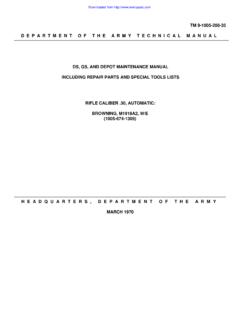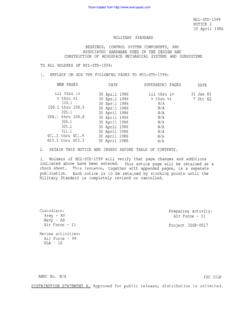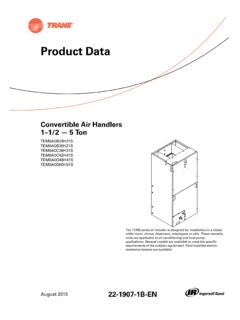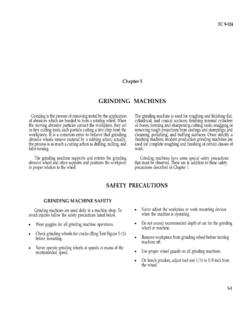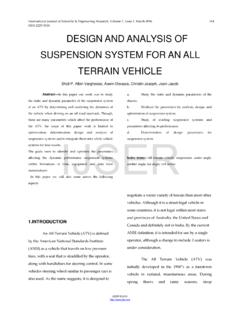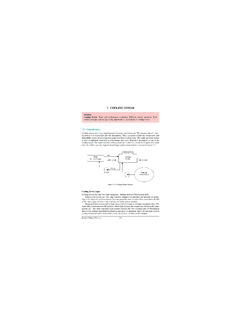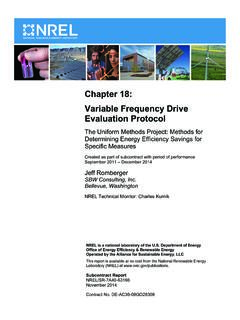Transcription of Handbook of Reliability Prediction Procedures for Mechanical …
1 Naval Surface Warfare CenterWest Bethesda, Maryland 20817-5700 HandbookofReliability Prediction ProceduresforMechanical EquipmentLogistics Technology Support CARDEROCKDIV, NSWC-10 January 2010 Approved for Public Release; Distribution is UnlimitedCarderock DivisionNaval Surface Warfare CenterCARDEROCK DIVISIONPREFACE Recognition of Reliability and maintainability (R&M) as vital factors in the development, production, operation, and maintenance of today's complex systems has placed greater emphasis on the application of design evaluation techniques to logistics management. An analysis of a design for Reliability and maintainability can identify critical failure modes and causes of unreliability and provide an effective tool for predicting equipment behavior and selecting appropriate logistics measures to assure satisfactory performance.
2 Application of design evaluation techniques can provide a sound basis for determining spare parts requirements, required part improvement programs, needed redesign efforts, reallocation of resources and other logistics measures to assure that specified Reliability and maintainability requirements will be met. Many efforts have been applied toward duplicating the data bank approach or developing a new approach for Mechanical equipment. The statistical analysis of equipment aging characteristics, regression techniques of equipment operating parameters related to failure rates, and analysis of field failure data have been studied in attempts to develop a methodology that can be used to evaluate a new Mechanical design for R&M characteristics.
3 Many of the attempts to develop R&M Prediction methodology have been at a system or subsystem level. The large number of variables at these levels and lack of detailed knowledge regarding operating environment have created a problem in applying the results to the design being evaluated. Attempts to collect failure rate data or develop an R&M Prediction methodology at the system or subsystem level produce a wide dispersion of failure rates for apparently similar components because of the basic characteristics of Mechanical components. The Design Evaluation Techniques program was initiated by the Carderock Division of the Naval Surface Warfare Center (CDNSWC) and was sponsored by the Office of Naval Technology under the Logistics Exploratory Development Program, 62233N.
4 The methodology for predicting R&M characteristics as part of this development effort does not rely solely on failure rate data. Instead, the design evaluation Procedures consider the material properties, operating environment and critical failure modes at the component part level to evaluate a design for R&M. The purpose of this Handbook is to present the proposed methodology for predicting the Reliability of Mechanical equipment and solicit comments as to the potential utility of a standard reference for Reliability predictions of Mechanical equipment. The development of this Handbook by the Logistics Technology Support Group (Code 2120) of CDNSWC was coordinated with the military, industry and academia. Sponsors of this effort included the U.
5 S. Army Armament Research, Development & Preface Revision A iPreface Revision A iiEngineering Center (SMCAR-QAH-P), Picatinny Arsenal and the Robins AFB, WR-ALC/LVRS.
6 These sponsors have provided valuable technical guidance in the development of the methodology and Handbook . Chapter 1 of the Handbook provides a summary of the testing program to validate the Prediction methodology. Also, the Robins AFB supplied an MC-2A Air Compressor Unit for validation testing purposes. The Procedures contained in this Handbook were used to predict the failure modes of the MC-2A and their frequency of occurrence. Reliability tests were then performed with a close correlation between predicted and actual Reliability being achieved. Past sponsors and participants in the program include the Belvoir Research, Development, & Engineering Center; Wright-Patterson AFB; Naval Sea Systems Command; Naval Air Test Center and Louisiana Tech University.
7 Previous editions of this Handbook were distributed to interested engineering personnel in industry and DoD for comments as to the utility of the methodology in evaluating Mechanical designs for Reliability . The comments have been extremely useful in improving the Prediction methodology and contents of the Handbook . The revised Handbook is available at no charge and can be downloaded by visiting the CDNSWC website ( ). Every effort has been made to validate the equations presented in this Handbook . However, limited funding has prevented the extensive testing and application of Prediction Procedures to the design/procurement process for full validation of the approach. Therefore, users are cautioned that this Handbook is the result of a research program and not an official DoD document.
8 Several companies have chosen to produce software packages containing the material in this Handbook , the attempt being to sell a software package whereby the Reliability of Mechanical components can be predicted in the same way as electronic components. The Navy has not been and is not now in any way connected with the commercial ventures to produce software packages. As described previously, it is important to understand the difference between the failure rate data used to evaluate electronic equipment and the Procedures used to evaluate Mechanical equipment. For a company to extract equations from the Handbook without regard to the application Procedures is in violation of the intent of the Handbook , the result being a potentially dangerous situation for the user in logistically relying on inaccurate results.
9 Another result is the damaging reputation to CDNSWC and the Navy in their attempts to improve the Reliability of Mechanical equipment through a greater understanding of Mechanical system design. To extract equations from the Handbook without regard to the Procedures and parameter limits defeats the purpose of the Handbook in helping the designer of Mechanical systems gain a greater insight as to the Reliability of his design. CDNSWC has developed a software package that automates the use of Procedures and equations in the Handbook that can be used to evaluate the methodology. This software program called MechRel can be downloaded free of charge by visiting the CDNSWC website. In summary, the Handbook and associated software package representing many years of research and development are already available at no charge.
10 Commercial exploitation of this work by extracting material without the full Preface Revision A iiicontent of the evaluation Procedures violates the purpose of the work being done by CDNSWC. Any product sold using material from the Handbook or referencing the Handbook must contain a statement that CDNSWC and the Navy have not participated in the development of or approve of their product. Interested users of the technology presented in this Handbook are urged to contact CDNSWC to obtain the latest available information on Mechanical Reliability .


